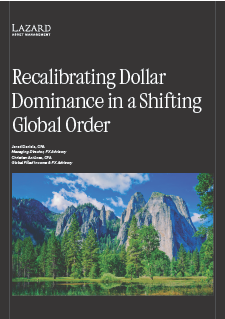Executive Summary
We believe the reshaping of American trade policy and the overturning of post-war geopolitical norms by an unconventional US administration have been the primary drivers of the US dollar’s significant year-to-date depreciation. Rising concerns over the cost of servicing the growing federal debt, amplified by the “One Big Beautiful Bill”, along with high-profile challenges to US institutions including the Federal Reserve (the Fed), have also contributed to investor unease.
A Tough Year to Date for the Dollar
As of 30 September 2025.
Source: Lazard, Bloomberg
This dollar weakness has served as a reminder to international investors, many of whom have benefited from holding dollars in the long bull market in US financial assets, that currency exposure counts.
However, a broader perspective is needed. We consider concerns the dollar could lose its status as the world’s reserve currency to be overblown. Longstanding and deeply embedded structural reasons support the dollar’s continued prominence, while fiat and digital currency alternatives are not viable leaders of the global currency order at this stage.
We see signs that investors outside the US are recalibrating their considerable dollar exposures after a lengthy period of ascendancy for the currency and US financial assets. We believe this will contribute to a further, albeit modest, softening in the dollar, supported by the Fed resuming its easing cycle, diverging from the monetary policy trajectories of the eurozone and Japan. A weaker dollar should continue to underpin non-US assets, particularly emerging markets, helping them build on their strong showing thus far in 2025.
Related Articles
Important Information
Published on 21 October 2025.
Certain information contained herein constitutes “forward-looking statements” which can be identified by the use of forward-looking terminology such as “may,” “will,” “should,” “expect,” “anticipate,” “target,” “intent,” “continue,” or “believe,” or the negatives thereof or other variations thereon or comparable terminology. Due to various risks and uncertainties, actual events may differ materially from those reflected or contemplated in such forward-looking statements.
This document reflects the views of Lazard Asset Management LLC or its affiliates (“Lazard”) based upon information believed to be reliable as of the publication date. There is no guarantee that any forecast or opinion will be realized. This document is provided by Lazard for informational purposes only. Nothing herein constitutes investment advice or a recommendation relating to any security, commodity, derivative, investment management service, or investment product. Investments in securities, derivatives, and commodities involve risk, will fluctuate in price, and may result in losses. Certain assets held in Lazard’s investment portfolios, in particular alternative investment portfolios, can involve high degrees of risk and volatility when compared to other assets. Similarly, certain assets held in Lazard’s investment portfolios may trade in less liquid or efficient markets, which can affect investment performance. Past performance does not guarantee future results. The views expressed herein are subject to change, and may differ from the views of other Lazard investment professionals. This document is intended only for persons residing in jurisdictions where its distribution or availability is consistent with local laws and Lazard’s local regulatory authorizations. Please visit www.lazardassetmanagement.com/globaldisclosure for the specific Lazard entities that have issued this document and the scope of their authorized activities.




